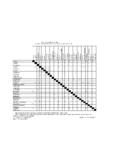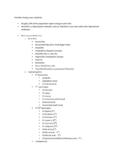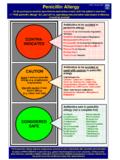Transcription of PENICILLIN ALLERGENIC DETERMINANTS - …
1 PENICILLIN ALLERGENIC DETERMINANTS ( DAP ) DESCRIPTION Main ALLERGENIC DETERMINANTS involved in type I or immediate hypersensitivity to benzylpenicillin and related antibiotics (beta-lactam), isolated, modified, and stabilised by means of lyophilisation. For exclusive use in the diagnosis of type I or immediate hypersensitivity to benzylpenicillin and related antibiotics (beta-lactam) by means of cutaneous tests (prick and intradermal tests). QUALITATIVE AND QUANTITATIVE COMPOSITION PENICILLIN ALLERGENIC DETERMINANTS are classified and labelled as: - Major Determinant Benzylpenicilloyl poly-L-lysine (PPL): formed by the bonding of the primary determinant of benzylpenicillin and related antibiotics (beta-lactam) to lysine chains. - Minor Determinant Mix (MDM): formed by Sodium benzylpenicillin, Benzylpenicilloic acid, and Sodium benzylpenicilloate, which are involved in the sensitisation to benzylpenicillin and related antibiotics (beta-lactam).
2 The DAPs quali-quantitative composition is the following: PPL Vial: Benzylpenicilloyl poly-L-lisine mg Mannitol 20 mg MDM Vial: Sodium benzylpenicillin mg Benzylpenicilloic acid mg Sodium benzylpenicilloate mg Mannitol 20 mg Diluent Vial: Sodium Chloride. Potassium dihydrogen phosphate Disodium hydrogen phosphate 2 hydrate Potassium chloride Water for injection 1 ml PHARMACEUTICAL FORM AND CONTAINER CONTENT Vials containing lyophilised powder and diluent for injectable solution.
3 DAP: diagnostic set 3 vials containing PPL (benzylpenicilloyl poly-L-lysine) lyophilised powder. 3 vials containing MDM, Minor Determinant Mix (Sodium benzylpenicillin, Benzylpenicilloic acid, and Sodium benzylpenicilloate), lyophilised powder. 6 diluent vials, each containing 1 ml of saline solution in phosphate buffer. Individualised vials containing: PPL: Lyophilised powder of Benzylpenicilloyl poly-L-lysine (PPL) MDM: Lyophilised powder of Minor Determinant Mix (MDM) (Sodium benzylpenicillin,Benzylpenicilloic acid, and Sodium benzylpenicilloate). Diluent Saline solution in phosphate buffer (1 ml) HOLDER AND MANUFACTURER Diater S. A. Calle Soledad n 37; 28330 San Mart n de la Vega. (Madrid) Spain. Telephone: +34 91 808 77 27 Fax: +34 91 895 80 24 E-mail: THERAPEUTIC INDICATIONS Diagnostic evaluation, by means of cutaneous tests (prick and intradermal tests), of allergic states, sensitisation, or type I hypersensitivity, in those cases in which allergy to beta-lactam antibiotics is suspected.
4 CONTRAINDICATIONS A pathological dermal alteration of the area intended for the cutaneous tests, as well as any other pathological state which may considerably affect the patient s general condition, constitute contraindications for the performance of cutaneous tests. The course of an acute allergic reaction induced by any ALLERGENIC substance constitutes a contraindication for the performance of cutaneous tests. Antihistamines, corticosteroids, cromones and, in general, any medication which exhibits collateral anti-allergic activity, must be suspended 1 week prior to the cutaneous examination. The use of beta-blocker or ACE inhibitor therapy also constitutes a contraindication for the performance of cutaneous tests; therefore, always in agreement with your prescribing physician and with blood pressure monitoring, it must be suspended during the 48 hours prior to the test. Pregnancy, breastfeeding, and, generally, being under six years of age, constitute contraindications for the performance of cutaneous tests; however, it should always be left to the Specialist s discretion, who must determine the convenience of, and the best timing for, the diagnostic cutaneous examination on the basis of the risk benefit required by each specific situation.
5 The contraindications derived from the administration of adrenaline must be considered, given the potential induction of a secondary allergic reaction. SPECIAL WARNINGS The performance of cutaneous tests during pregnancy is not recommended, given the additional risk the potential induction of an anaphylactic reaction entails. After performing the cutaneous tests, the patient must remain under observation for at least 30 minutes. In addition, it is advisable that the patient avoid alcohol consumption, intense physical exercise, and hot baths or showers during the hours prior and subsequent to the test. In the event that the patient is under treatment with allergen immunotherapy, it is advisable that the cutaneous tests be performed with a 1-week minimum interval from the preceding immunotherapy dose. Similarly, the interval between the cutaneous tests and administration of an immunotherapy dose should be 2 or 3 days.
6 PRECAUTIONS FOR USE Cutaneous tests using DAP must begin by studying cutaneous reactivity to the Major Determinant (PPL). The minor determinant mix (MDM) should only be used when the result of the cutaneous test using the Major Determinant (PPL) has been negative. Cutaneous tests must always start with the prick test technique. Intradermal tests should be used only when the prick tests are negative. As a preventive measure, it is advisable to apply a set of dilutions, at a ratio of 1:100 and 1:10, prior to starting the Major Determinant (PPL) and/or the minor determinant mix (MDM) intradermal tests. In patients with symptoms compatible with a severe reaction, or with a high risk, the dilutions for the cutaneous tests should begin at 1:1,000. In cutaneous tests, it is advisable to follow the algorithm for the study of sensitivity to PENICILLIN DETERMINANTS shown below: Major Determinant PPL prick test === positive (non-diluted) Negative Major Determinant PPL intradermal test === positive (recommended dilution 1:10) Negative Major Determinant PPL intradermal test === positive (non-diluted) Negative Minor determinant mix MDM prick test == positive (non-diluted) Negative Minor determinant mix MDM intradermal test == positive (recommended dilution 1:100) Negative Minor determinant mix MDM intradermal test positive (recommended dilution 1:10) Negative Minor determinant mix MDM intradermal test positive (non-diluted) Negative The dilutions must be performed while maintaining the required appropriate aseptic conditions and using the diluents which may be requested to that end.
7 INTERACTIONS Antihistaminic, corticosteroids, cromones, and, in general, any medications which exhibit collateral anti-allergic activity have an interaction capacity which alters the results that may be obtained after performing the cutaneous tests. In the specific case of oral antihistaminic, it is necessary to suspend their administration 1 week before the cutaneous examination. INSTRUCTIONS FOR USE Preparation of the diagnostic solutions for cutaneous tests Select and verify the expiration dates and the condition of the vials that are to be reconstituted. Under sterile conditions, and using a sterile syringe and needle, remove 1 ml of the diluent and transfer it to the DAP vial containing the lyophilised powder that is to be reconstituted, while shaking it lightly. It will then be ready for immediate use. Cutaneous tests by means of the prick test technique The prick test technique is one of the most widely used techniques for evaluation of the majority of allergic processes and which entails the lowest risk of inducing anaphylaxis.
8 This cutaneous test, which is practically free of irritating effects, is performed by placing a drop of the ALLERGENIC determinant on the skin of the palmar face of the patient s forearm. Using a special 1-mm-tip lancet, the epidermis is pierced at a right angle, allowing for the solution to penetrate through the skin, and the excess liquid is removed immediately thereafter. In no case should the result of a prick test be assessed if blood is produced. It is common for a small erythematous area to appear around the site where the test was performed. Cutaneous tests by means of the intradermal technique The intradermal test involves administration of an ALLERGENIC determinant dose close to ml at the dermis level. This is done using a 4/10-caliber-needle tuberculin syringe, which is applied to the palmar face of the patient s forearm at a 10 15 degree angle, forming a small blister whose perimeter must be marked at the beginning of the test.
9 One must make sure not to injure any vessels while performing the test; should this occur, the result will not be assessed. Patient conditions during the performance of cutaneous tests Even though special skin care is not necessary prior to performing cutaneous tests, one must remember to assess dermographism and clean the selected area, preferably with water and without vigorous rubbing. Prior to performing the cutaneous tests, the patient must be tempered for at least 10 minutes. Reading and interpretation of the cutaneous test results The final cutaneous test results must be read once 15-20 minutes have elapsed since their performance, with periodical observation. Interpretation of the cutaneous prick test results is based on the size of the induced papule; tests are considered positive when the papule has a diameter greater than 3 mm or exhibits pseudopod formation. The following assessment key may be used: Papule major diameter Cutaneous test interpretation 3 mm Negative > 3 mm Positive In intradermal tests, if the difference between the initial and the induced diameters is greater than 3 mm, the test is considered to be positive.
10 It is essential to observe and monitor the patient during the development of his/her cutaneous response, until the reading is done, in order to be able to act immediately in the event of any adverse, local or systemic reaction which may occur. OVERDOSE In the event of accidental overdose or incorrect performance of the cutaneous test, usually injury to a vessel and, consequently, endovenous administration, a more or less significant adverse reaction may appear, including anaphylaxis, which should be treated as indicated in the section on adverse reactions. ADVERSE REACTIONS Adverse reactions may be immediate or delayed, depending on how long the symptoms take to appear: seconds or minutes and hours, respectively, after performing the cutaneous test, and may be classified as: Local reactions In terms of symptoms, they entail the development and persistence of an erythema, edema, or inflammation, with or without pruritis, on the cutaneous test site, which usually appears after 10 to 60 minutes and persists for several hours.






